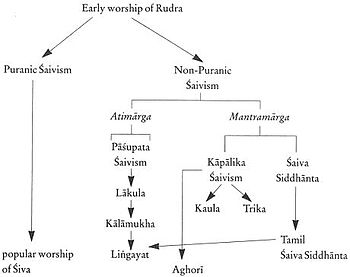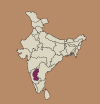
|
|
History · Deities |
|---|
|
Beliefs and practices
Philosophy · Dharma |
|
Vedas · Upanishads |
|
Related topics
Hinduism by country |
Shaivism or Saivism is one of the four most widely followed sects of Hinduism, which reveres the god Shiva as the Supreme Being. It is also known as śaiva paṁtha (Sanskrit: शैव पंथ; lit. "pantha associated with Shiva") and Saivam (Tamil: சைவம்). Followers of Shaivam are called "Shaivas" (also "Saivas", "Shaivites" or "Saivarkal"). They believe that Shiva is All and in all, the creator, preserver, destroyer, revealer and concealer of all that is. Shaivism is widespread throughout India, Nepal and Sri Lanka. Areas notable for the practice of Shaivism include parts of Southeast Asia, especially Malaysia, Singapore, and Indonesia.
Shiva is sometimes depicted as the fierce god Bhairava. Saivists are more attracted to asceticism than adherents of other Hindu sects, and may be found wandering India with ashen faces performing self-purification rituals.[1][2][3] They worship in the temple and practice yoga, striving to be one with Siva within.[4]
General features[]
Sacred ash came to be used as a sign of Shaivism. Devotees of Shiva wear it as a sectarian mark on their foreheads and other parts of their bodies with reverence. The Sanskrit words bhasma[5] and vibhuti[6] can both be translated as "sacred ash".
History[]

The Development of the Saiva Traditions
It is very difficult to determine the early history of Shaivism. Shaivism is the oldest worship of hinduism. Pashupata was the first Lord worshipped.[7] The Śvetāśvatara Upanishad (400 - 200 BCE)[8] is the earliest textual exposition of a systematic philosophy of Shaivism.[9] As explained by Gavin Flood, the text proposes:
- "... a theology which elevates Rudra to the status of supreme being, the Lord (Sanskrit: Īśa) who is transcendent yet also has cosmological functions, as does Śiva in later traditions.[10]"
- ―{{{2}}}
During the Gupta Dynasty (c. 320 - 500 CE) Puranic religion developed and Shaivism spread rapidly, eventually throughout the subcontinent, spread by the singers and composers of the Puranic narratives.[11]
Major schools[]

Shaivism Groupings
Shaivism has many different schools reflecting both regional and temporal variations and differences in philosophy.[12] Shaivism has a vast literature that includes texts representing multiple philosophical schools, including non-dualist (abheda), dualist (bheda), and non-dual-with-dualism (bhedābheda) perspectives.[13]
Puranic and non-Puranic[]
A review of Shaivite groups makes a broad distinction into two groups, with further subdivisions within each group:[14]
- Vedic, Puranic. Shaivism as a Vedic Origin is a practice of "DARK" Values and "Shiva & Parvathi Lila". Science is the basis of this Religion. The Sections of "Smartha" Brahmins in South and North comprise the Shaivism Practise of Vedic Religion; the Sanatana Dharma. The Shiva Purana is the ultimate resource of the Historical Presence of Shaivism in Society of Modern India.
- Non-Puranic. These devotees are distinguished by undergoing initiation (dīkṣa) into a specific cult affiliation for the dual purposes of obtaining liberation in this life (mukti) and/or obtaining other aims (bhukti). Sanderson subdivides this group further into two subgroups:
- Those that follow the outer or higher path (atimārga), seeking only liberation. Among the atimārga groups two are particularly important, the Pāśupatas and a sub-branch, the Lākula, from whom another important sect, the Kālāmukhas, developed.[15]
- Those that follow the path of mantras (mantramārga), seeking both liberation and worldly objectives.
Pashupata Shaivism[]
Pashupata Shaivism: The Pashupatas (Sanskrit: Pāśupatas) are the oldest named Shaivite group.[16] The Pashupatas were ascetics.[17] Noted areas of influence (clockwise) include Gujarat, Kashmir and Nepal. But there is plentiful evidence of the existence of Pāśupata groups in every area of the Indian subcontinent. In the far South, for example, a dramatic farce called the Mattavilāsanaprahasana ascribed to a seventh-century Pallava king centres around a Pāśupata ascetic in the city of Kāñcīpuram who mistakes a Buddhist mendicant's begging bowl for his own skull-bowl. Inscriptions of comparable date in various parts of South East Asia attest to the spread of Pāśupata forms of Śaivism before the arrival there of tantric schools such as the Shaiva Siddhanta.[18]
Shaiva Siddhanta[]
Shaiva Siddhanta: Considered normative tantric Saivism, Shaiva Siddhanta provides the normative rites, cosmology and theological categories of tantric Saivism.[19] There is a dualistic dimension to Shaivism, as expounded by Meykandar. The pure, or Shuddha Saivism,however, proclaimed by Rishi Thirumular and his paramparai (guru lineage), is strictly non-dualistic, and proclaims the soul to be at all times one with Shiva.[20] This tradition was once practiced all over India. For example, the theologians Sadyojoti, Bhatta Nārāyanakantha and his son Bhatta Rāmakantha (ca. 950-1000 AD) developed a sophisticated Siddhanta theology in Kashmir.[21] However the Muslim subjugation of north India restricted Shaiva Siddhanta to the south,[22] where it merged with the Tamil Saiva cult expressed in the bhakti poetry of the Nayanars(600 C.E. and 1100 C.E).[23] It is in this historical context that Shaiva Siddhanta is commonly considered a "southern" tradition, one that is still very much alive.[24]
Kashmir Shaivism[]
Kashmir Shaivism: Kashmir Saivism, a householder religion, was based on a strong monistic interpretation of the Bhairava Tantras (and its subcategory the Kaula Tantras), which were tantras written by the Kapalikas.[25] There was additionally a revelation of the Siva Sutras to Vasugupta.[26] Kashmir Saivism claimed to supersede the dualistic Shaiva Siddhanta.[27] Somananda, the first theologian of monistic Saivism, was the teacher of Utpaladeva, who was the grand-teacher of Abhinavagupta, who in turn was the teacher of Ksemaraja.[28][29] The label Kashmir Shaivism, though unfortunately now widely adopted, is really a misnomer, for it is clear that the dualistic Shaiva Siddhanta was also in North India at one point in time.
Siddha Siddhanta[]
Natha Siddha Siddhanta: Founded by Matsyendranatha (ca 800–1000) and expounded by Rishi Gorakshanatha (ca 950), this monism is known as Bhedabheda, embracing both the transcendent Shiva as well as the immanent Shiva. Shiva is efficient and material cause. The creation and final return of soul and cosmos to Shiva are likened to bubbles arising and returning to water. Influential in Nepal, Uttar Pradesh, Bihar and West Bengal.
Lingayatism[]
Lingayatism: Made popular by Basavanna (1105–1167), this version of qualified nondualism, Shakti Vishishtadvaita, accepts both difference and nondifference between soul and God, like rays are to the sun. Shiva and the cosmic force are one, yet Shiva is beyond His creation, which is real, not illusory. God is efficient and material cause. Influential primarily in Karnataka.
Shiva Advaita[]
Shiva Advaita: This monistic theism, formulated by Srikantha (ca 1050), is called Shiva Vishishtadvaita. The soul does not ultimately become perfectly one with Brahman, but shares with the Supreme all excellent qualities. Appaya Dikshita (1554–1626) attempted to resolve this union in favor of an absolute identity—Shuddhadvaita. Its area of origin and influence covers most of Karnataka state.
Shaivism left a major imprint on the intellectual life of classical Cambodia, Champa in what is today southern Vietnam, Java and the Tamil lands. The wave of Shaivite devotionalism that swept through late classical and early medieval India redefined Karnataka and Tamil Nadu. Shaivite worship legitimized several ruling dynasties in pre-modern India, incluidng the Chola and the Rajputs. A similar trend was witnessed in early medieval Indonesia with the Majapahit empire and pre-Islamic Malaya.[30][31] Nepal is the only country in the world where Shaivism is the most popular form of Hinduism.
Shaivite literature and texts[]
The Śvetāśvatara Upanishad (400 - 200 BCE)[32] is the earliest textual exposition of a systematic philosophy of Shaivism.[33] The Shiva Rahasya Purana, an Upapurana, is an important scriptual text.
One of the most important text of Shaivism is Tirumurai.
See also[]
- History of Shaivism
- Kaśmir Śaivism
- Lingayatism
- Nataraja
- Shaiva Siddhanta
- Vibhuti
- Siddha
- Shaktism
- Tirumular
- Vaishnavism
- Sufism
- Sophia (wisdom)
- Ein Sof
References[]
- ↑ "ISKCON". http://hinduism.iskcon.org/tradition/1200.htm. Retrieved 7 February 2014.
- ↑ "Hindus in SA". http://www.hinduism.co.za/hindu3.htm. Retrieved 7 February 2014.
- ↑ Dubois. Hindu Manners, Customs and Ceremonies. Cosimo. p. 111. http://books.google.co.in/books?id=4zMY2qURR-8C&pg=PA111&dq=hindu+sects&hl=en&sa=X&ei=MLD0UpvBNsLulAXmq4C4DA&ved=0CDsQ6AEwAw#v=onepage&q=hindu%20sects&f=false.
- ↑ "HimalayanAcademy". http://www.himalayanacademy.com/readlearn/basics/four-sects. Retrieved 7 February 2014.
- ↑ Apte, p. 714.
- ↑ Apte, p. 866
- ↑ Tattwananda 1984, p. 45.
- ↑ For dating to 400-200 BCE see: Flood (1996), p. 86.
- ↑ For Śvetāśvatara Upanishad as a systematic philosophy of Shaivism see: Chakravarti 1994, p. 9.
- ↑ Flood (1996), p. 153.
- ↑ For Gupta Dynasty (c. 320 - 500 CE) and Puranic religion as important to the spread across the subcontinent, see: Flood (1996), p. 154.
- ↑ For an overview of the Shaiva Traditions, see Flood, Gavin, "The Śaiva Traditions", in: Flood (2003), pp. 200-228. For an overview that concentrates on the Tantric forms of Śaivism, see Alexis Sanderson's magisterial survey article Śaivism and the Tantric Traditions, pp.660--704 in The World's Religions, edited by Stephen Sutherland, Leslie Houlden, Peter Clarke and Friedhelm Hardy, London: Routledge, 1988.
- ↑ Tattwananda 1984, p. 54.
- ↑ For overview of Sanderson's method of grouping, see: Flood (2003), p. 206.
- ↑ For the classifiction of Sanderson into atimārga and mantramārga, and characterization of the Pāśupatas, Lākula, and Kālāmukhas, see: Sanderson (1988) and Flood (2003), p. 206.
- ↑ For the Pāśupatas as the oldest named Śaiva group, see: Flood (2003), p. 206.
- ↑ For Pāśupata as an ascetic movement see: Michaels (2004), p. 62.
- ↑ See Alexis Sanderson's Śaivism among the Khmers Part I, pp. 349--462 in the Bulletin de l'Ecole française d'Extrême-Orient 90--91 (2003--2004).
- ↑ Flood, Gavin. D. 2006. The Tantric Body. P.120
- ↑ Subramuniyaswami, Sivaya, Dancing with Siva, Merging with Siva.
- ↑ Flood, Gavin. 2003. The Blackwell Companion to Hinduism. Malden: Blackwell. pg. 210.
- ↑ Flood, Gavin. D. 2006. The Tantric Body. P.34
- ↑ Flood, Gavin. D. 1996. An Introduction to Hinduism. P.168
- ↑ Flood, Gavin. D. 1996. An Introduction to Hinduism. P.168
- ↑ Flood, Gavin. D. 1996. An Introduction to Hinduism. P.164-167
- ↑ Flood, Gavin. D. 1996. An Introduction to Hinduism. P.164-167
- ↑ Flood, Gavin. D. 2006. The Tantric Body. P.61
- ↑ Flood, Gavin. D. 1996. An Introduction to Hinduism. P.164-167
- ↑ Flood, Gavin. D. 2006. The Tantric Body. P.66
- ↑ Sastri, K.A. Nilakanta. "A Historical Sketch of Saivism", in: Bhattacharyya (1956), Volume IV pages 63 -78.
- ↑ For more on the subject of Saivite influence on Indonesia, one could read N.J.Krom, Inleiding tot de Hindoe-Javaansche Kunst/Introduction to Hindu-Javanese Art, The Hague, Martinus Nijhof, 1923
- ↑ For dating to 400-200 BCE see: Flood (1996), p. 86.
- ↑ For Śvetāśvatara Upanishad as a systematic philosophy of Shaivism see: Chakravarti 1994, p. 9.
Sources[]
- Bhandarkar, Ramakrishna Gopal (1913). Vaisnavism, Śaivism, and Minor Religious Systems. New Delhi: Asian Educational Services. ISBN 81-206-0122-X. Third AES reprint edition, 1995.
- Bhattacharyya (Editor), Haridas (1956). The Cultural Heritage of India. Calcutta: The Ramakrishna Mission Institute of Culture. Four volumes.
- Chakravarti, Mahadev (1994), The Concept of Rudra-Śiva Through The Ages (Second Revised ed.), Delhi: Motilal Banarsidass, ISBN 81-208-0053-2
- Flood, Gavin (1996). An Introduction to Hinduism. Cambridge: Cambridge University Press. ISBN 0-521-43878-0.
- Flood, Gavin (Editor) (2003). The Blackwell Companion to Hinduism. Malden, MA: Blackwell Publishing Ltd.. ISBN 1-4051-3251-5.
- Keay, John (2000). India: A History. New York: Grove Press. ISBN 0-8021-3797-0.
- Tattwananda, Swami (1984), Vaisnava Sects, Saiva Sects, Mother Worship (First Revised ed.), Calcutta: Firma KLM Private Ltd.
External links[]
- New World Encyclopedia, Shaivism
- Encyclopedia Brittanica, Shaivism
- Thirumoolar Vibhuthi -Original Vibhuti from Swadeshi Cows
External links[]
| ||||||||||||||||||||||||||
Template:Veerashaivism
| This Creative Commons Licensed page uses content from Wikipedia (view authors). The text of Wikipedia is available under the license Attribution-Share Alike 3.0 Unported (ToU). |

